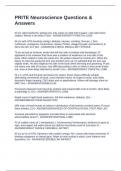PRITE Neuroscience Questions &
Answers
60 y/o right-handed M, getting lost, only writes on right half of paper. Left-sided hemi-
neglect. Where is the lesion? (8x) - ANSWERSRIGHT PARIETAL LOBE
66 y/o with HTN develops vertigo, diplopia, nausea, vomiting, hiccups, L face
numbness, nystagmus, hoarseness, ataxia of limbs, staggering gait, and tendency to
fall to the left. Dx? (8x) - ANSWERSLATERAL MEDULLARY STROKE
78 y/o pt had an ischemic stroke that left him with a residual mild hemiplegia. Pt
appeared to be unaware that there was a problem of weakness on one side of this
body. When asked to raise the weak arm, the patient raised his normal arm. When the
failure to raise the paralyzed arm was pointed out to pt, he admitted that the arm was
slightly weak. He also neglects the side of the body when dressing and grooming. Pt did
not shave one side of his face, had difficulty putting a shirt on when it was turned inside
out. Area of brain likely affected by stroke? (4x) - ANSWERSRIGHT PARIETAL LOBE
26 y.o. w/HA and R-hand clumsiness for weeks. Exam shows difficulty w/rapid
alternating movements of hand, overt intention tremor on finger-to-nose, and mildly
dysmetric finger tamping. CNS intact and no papilledema. Where will damage show on
MRI? (4x) - ANSWERSCEREBELLUM
Previously pleasant mom becomes profane and irresponsible over 6 months. Most likely
a pathology in: (2x) - ANSWERSFRONTAL LOBE
Rapid onset of right facial weakness, left limb weakness, diplopia: (2x) -
ANSWERSBRAIN STEM INFARCTION
MRI scan of head reveals an infarct in distribution of left anterior cerebral artery. Pt most
likely exhibits: (2x) - ANSWERSWEAKNESS OF CONTRALATERAL FOOT AND LEG
Amnesia preceded by epigastric sensation/fear is associated with electrical
abnormalities where? - ANSWERSTEMPORAL LOBE
Pt w/ sudden onset of L hemiparesis, L homonymous hemianopsia, tendency to gaze to
right, and neglect left sided stimuli are deficits most likely result of occlusion of: -
ANSWERSRIGHT MIDDLE CEREBRAL ARTERY
65 y/o w/ hx of HTN, Meniere's with sudden vertigo, N/V, worse with head movement, R
beating nystagmus on lateral gaze, finger to nose testing is ataxic, poor balance and
dysarthria. Dx - ANSWERSCEREBELLAR INFARCT
, Lower facial weakness w/ relative sparing of forehead, stroke in? -
ANSWERSINTERNAL CAPSULE
Higher frequency & greater severity of depression associated w/ cortical & subcortical
strokes: - ANSWERSLEFT ANTERIOR FRONTAL
58 y/o s/p CABG - anomia for fingers and body parts, errors involving right and left,
inability to write thoughts/take notes/make calculations. Fluent speech and excellent
comprehension - ANSWERSLEFT MEDIAL TEMPORAL STROKE
Visual disturbances associated with occlusion of the right posterior cerebral artery? -
ANSWERSLEFT HOMONYMOUS HEMIANOPSIA
65 y/o w/ HTN collapsed. In ED is stuporous, R hemiparesis + hemisensory deficit, eyes
deviate to L. CT would show intraparenchymal hemorrhage in: - ANSWERSLEFT
BASAL GANGLIA
Atrophy of right temporal lobe on cross section associated with occlusion of: -
ANSWERSMIDDLE CEREBRAL ARTERY
58 y/o M h/o HTN, cig smoking and sudden inability to speak. Face drooping on R and
dragging R leg. In ER examined within 40 mins of onset: Aphasic, unable to understand
or repeat verbal commands. Unintelligible sounds for speech. Alert but appears
frustrated. R hemiplegia with arm and face weaker than leg. CT head: no hemorrhage.
Pathology type and area: - ANSWERSTHROMBOEMBOLIC STROKE OF LEFT MCA
Sudden onset vertigo/nausea, hoarseness/dysphagia, right sided face numbness,
diminished gag reflex on right, decreased pinprick and temperature sensation on left: -
ANSWERSRIGHT MEDULLARY INFARCTION
65 y/o diabetic pt presents to ED c/o acute L sided weakness, deviation of gaze to R, L
hemiplegia and hemisensory deficit, and L homonymous hemianopsia. 12 hrs later, pt is
unconscious, L pupil enlarged and unreactive. CT will show what? - ANSWERSR MCA
INFARCT W/ EDEMA AND UNCAL HERNIATION
Pt with acute onset vertigo, what will suggest R lateral medullary infarct? -
ANSWERSRIGHT FACIAL LOSS OF TOUCH AND TEMPERATURE SENSATION
46 y/o M w/ double vision + pain R eye. Exam: ptosis R eyelid, inability to elevate or
adduct R eye + R pupillary dilation. This is caused by: - ANSWERSPOST.
COMMUNICATING ARTERY ANEURYSM
65 y/o pt has a stroke which causes him to fall. On exam, weakness of the right leg, with
only minor weakness of the right hand, no weakness of the face, no sensory deficit.
Speech is not affected, but pt seems unusually quiet and passive. The stroke most likely
involves the: - ANSWERSLEFT ANTERIOR CEREBRAL ARTERY




